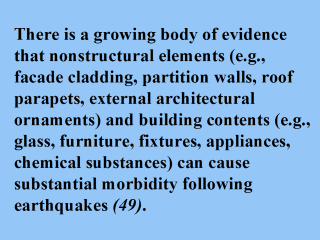| front |1 |2 |3 |4 |5 |6 |7 |8 |9 |10 |11 |12 |13 |14 |15 |16 |17 |18 |19 |20 |21 |22 |23 |24 |25 |26 |27 |28 |29 |30 |31 |32 |review |

|
In a study from the 1987
Whittier Narrows earthquake in southern California (magnitude 5.9), Bourque and others
reported that injuries occurred "primarily because objects fell from shelves or
walls, because parts of buildings fell, because of how the injured person behaved during
or immediately after the earthquake, or because the person fell during the
earthquake" (50). In another study, fall-related injuries were those most
frequently reported in the absence of structural collapse (31). This type of injury
accounted for almost 30% of those occurring during and after shaking. Most people who
incurred fall-related injuries after the shaking stopped were attempting to evacuate down
darkened exit stairs. Although most injuries from falls or from being struck by
nonstructural elements are minor compared with those sustained as a result of building
collapse, some physical objects (e.g., tall metal lockers, wine barrels, heavy filing
cabinets) and some settings (e.g., stairwells) are particularly hazardous and can cause
serious injuries. Although many structures may be at risk of damage in highly seismic areas, most deaths or serious injuries from earthquakes tend to occur in a relatively small number of damaged facilities widely scattered throughout the earthquake-affected area (5,51). For example, 50 of 62 deaths in the Loma Prieta earthquake occurred at the Cypress freeway structure in Oakland, and 40 of 64 deaths in the 1971 San Fernando earthquake occurred as a result of a collapse of a Veterans Hospital. Data on earthquakes in other countries also suggest that a relatively small number of damaged structures are the source of the vast majority of the serious casualties (5). |